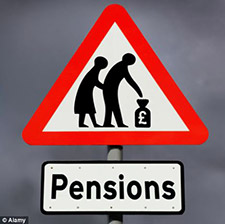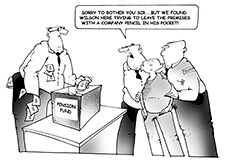Pensions
Pensions are a cornerstone of the safety net. They emerged here after the Civil War, when the nation felt an obligation to the many veterans who were hungry, jobless, and homeless. Even in the mid-19th century, long before police officers, firefighters and school teachers had the right to bargain collectively, cities and states supplemented lower wages and rewarded loyalty with the promise of pensions upon retirement. For public and private employees, pensions are essentially deferred wages.
Following WWII and the growth of unions, public and private pensions expanded, with most workers covered by defined benefit plans. Upon retirement these plans guaranteed a benefit level for life, based on years of service and earnings. Today defined benefit plans require employers to set aside pension savings, made up of employer and employee contributions, and invest them for future payouts. When adequately funded and invested such plans maximize efficiency with low administrative costs. For example, before the steep recession of 2008, taxpayers contributed only 14 cents for each dollar paid to retired teachers in New York’s teachers’ retirement system. The remaining 86 cents came from the earnings on investments from both employer and employee contributions.
 A union representative visits retired member and his wife to explain their pension benefits. Hotel and Motel Trades Council, 1973
A union representative visits retired member and his wife to explain their pension benefits. Hotel and Motel Trades Council, 1973Since 1980 private pension coverage has dramatically declined as employers abandoned defined benefit plans and switched to defined contribution plans, a boon to the powerful financial industry. However, these plans leave many workers either with no coverage or inadequate coverage. The risk is transferred from employers to workers. The same thing is true for 401k plans, which allow employees to allocate a portion of their salary for investment: contributions are not always matched by employers, funds are at the mercy of the market, and all too often the employee does not have the expertise to invest wisely.
Employers often ignore their fiduciary responsibilities to pension plans. Public employers sometimes don’t contribute their required share to the funds, thus leading to crises when the funds are unable to meet their obligations to retirees. Private sector employers may raid the pension funds, or try to spin them off. Unfortunately these abuses have attracted much less attention than the incidence of abuse by employees. Today’s service economy compounds the problem, with large numbers of low wage workers in the private sector receiving no pension benefits at all, increasing questions about taxes paid toward those public pensions.
Proposals to Change Pensions
State legislatures across the nation have enacted changes to public sector pension plans which threaten workers’ abilities to support themselves in old age. Notable are requirements that employees pay a greater percentage of their salary into pension funds, that employees accept reduced pensions, and that employees contribute over a longer time span to establish eligibility.

